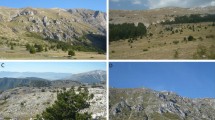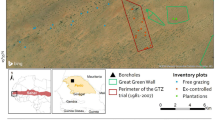Abstract
Colonization was studied in safety islands installed on a machine-graded downhill ski run (ca 2500m asl) and respectively aged 7, 8, and 9 years. For comparison, the neighbouring non-restored plots were investigated. The study included assessment of species richness (alpha diversity), size and spatial structure of the immigrant populations, and the nearest possible diaspore sources. The number of colonizing species recorded in the safety islands totalled 44 whereas only 25 species were found in the non-restored ski run plots close by. The mean species number per whole plot, per 1m2 and per 0.1m2 was significantly higher in the safety islands than in the non-restored ski run plots. Population founders and small populations represented more than half of all immigrant species in the safety islands, but medium-sized and large populations were also present. The overall distribution of plants was patchy but the number of individuals per 1m2 was significantly higher in the safety islands than in the ski run. Travelling distances separating the safety islands from the nearest possible diaspore source were often exceedingly short and ranged between 0.10m and 1m in 47.7% of all populations studied. It seems that the diaspore sources were mostly secondary i.e. plants scattered over the non-restored ski run, and those previously used in restoration trials, served as diaspore donors. The results of the study clearly demonstrate that successful colonization of machine-graded alpine ski runs in the study area is ultimately limited by safe-site availability and not by deficiencies in seed rain or remote diaspore sources. The colonization process in the safety islands is apparently well-advanced.
Similar content being viewed by others

References
Andersen, V.U. (1995) Succession and soil development in man-made coastal ecosystems at the Baltic Sea. Nord. J. Bot. 15, 91–104.
Chambers, J.C. (1997) Restoring alpine ecosystems in the western United States: environmental constraints, disturbance characteristics and restoration success. In Restoration Ecology and Sustainable Development (K.M. Urbanska, N.R. Webb and P.J. Edwards). Cambridge: Cambridge University Press (in press).
Chambers, J.C., MacMahon, J.A. and Haefner, J.A. (1991) Seed entrapment in disturbed alpine ecosystems: effects of soil particle size and diaspore morphology. Ecology 72, 1668–77.
Delarze, R. (1994) Dynamique de la végétation sur les pistes ensemencées de Crans-Montana (Valais, Suisse). Effects de l'altitude. Bot. Helv. 104, 3–16.
Densmore, R.V. (1992) Succession on an Alaskan tundra disturbance with and without assisted revegetation with grass. Arctic & Alpine Research 24, 238–43.
Eriksson, O. and Ehrlen, J. (1992) Seed and microsite limitation of recruitment in plant populations. Oecologia (Berlin) 91, 360–4.
Etter, R., Urbanska, K.M. and Fattorini, M. (1996) Restoration of alpine ski runs by volunteer teenagers — a lesson in environmental education. Proceedings of the 12th High Altitude Revegetation Workshop. Colo. Water Resour. Res. Inst. Info. Series 83, 318–19.
Fattorini, M. (1996) Post-restoration development of plant cover in a machine-graded ski run. Proceedings of the 12th High Altitude Revegetation Workshop. Colo. Water Resour. Res. Inst. Info. Series 83, 306–16.
Florineth, F. (1982) Begrünungen von Erosionszonen im Bereich und über der Waldgrenze. Zeitschr. Vegetationstechn. 5, 20–4.
Flüeler, R.P. (1992) Experimentelle Untersuchungen über Keimung und Etablierung von alpinen Leguminosen. Veröff. Geobot. Inst. der ETH Stiftung Rübel Zürich 110.
Gasser, M. (1986) Genetic-ecological investigations in Biscutella levigata L. Veröff. Geobot. Inst. ETH Stiftung Rübel Zürich 86.
Gasser, M. (1989) Bedeutung der vegetativen Phase bei alpinen Pflanzen für die biologische Erosionbekämpfung in der alpinen Stufe. Ber. Geobot. Inst. ETH, Stiftung Rübel, Zürich 55, 151–76.
Grieg Smith, P. (1957) Quantitative Plant Ecology. London: Butterworth Scientific Publications.
Hasler, A.R. (1992) Experimentelle Untersuchungen über klonal wachsende alpine Leguminosen. Veröff. Geobot. Inst. ETH, Stiftung Rübel, Zürich 111.
Hulme, P. (1996) Natural regeneration of yew (Taxus baccata L.): microsite, seed or herbivore limitation? J. Ecol. 84, 853–61.
Janzen, D.H. (1971) Seed predation by animals. Ann. Rev. Ecol. Syst. 2, 465–92.
Landolt, E. (1984) Unsere Alpenflora. Brugg: Schw. Alpenclub.
Marchand, P.J. and Roach, D.A. (1980) Reproductive strategies of pioneering alpine species: seed production, dispersal and germination. Arctic & Alpine Res. 12, 137–46.
Meisterhans, E. (1988) Vegetationsentwicklung auf Skipistenplanierungen der alpinen Stufe bei Davos. Veröff. Geobot. Inst. ETH, Stiftung Rübel, Zürich 85.
Müller-Schneider, P. (1986) Verbreitungsbiologie der Blütenpflanzen Graübundens. Veröff. Geobot. Inst. ETH, Stiftung Rübel, Zürich 85.
Olivieri, I. and Berger, A. (1985) Seed dimorphism for dispersal: physiological, genetic and demographical aspects. In Genetic Differential and Dispersal in Plants (P. Jacquard, G. Heim and J. Antonovics, eds) pp. 413–29. Berlin: Springer-Verlag.
Ruoss, E., Burga, C.A. and Eschman, J. (1995) Naturnahe Wiederbegrünung auf Pilatus Kulm (2060 \(\ddot \mu \).M). Mitt. Naturforsch. Ges. Luzern 34, 85–96.
Ryvarden, L. (1971) Studies in seed dispersal. I. Trapping of diaspores in the alpine zone at Finse, Norway. Norwegian J. Bot. 18, 215–26.
Schütz, M. (1988) Genetisch-ökologische Untersuchungen an alpinen Pflanzenarten auf verschiedenen Gesteinunterlagen: Keimungs-und Aussaatversuche. Veröff. Geobot. Inst. ETH, Stiftung Rübel, Zürich 99.
Spence, J.R. (1990) Seed rain in grassland, herbfield, snowbank, and fellfield in the alpine zone, Craigieburn Range, South New Zealand. New Zealand J. Bot. 28, 439–50.
Spence, J.R. and Shaw, R.J. (1983) Observations on alpine vegetation near the Schoolroom Glacier, Teton Range, Wyoming. Great Basin Nat. 43, 483–91.
Stolz, G. (1984) Entwicklung von Begrünungen oberhalb der Waldgrenze aus der Sicht der Botanik. Zeitschr. Vegetationstechn. 7, 29–34.
Tschurr, F.R. (1992) Experimentelle Untersuchungen über das Regenerationsverhalten bei alpinen Pflanzen. Veröff. Geobot. Inst. ETH Stiftung Rübel, Zürich 108.
Urbanska, K.M. (1989) Probleme des biologischen Erosionsschutzes oberrhalb der Waldgrenze. Zeitschr. Vegetationstechn. 12, 25–30.
Urbanska, K.M. (1992) Populationsbiologie der Pflanzen. Stuttgart: G. Fischer-Verlag.
Urbanska, K.M. (1994a) Ecological restoration above the timberline: demographic monitoring of whole trial plots in the Swiss Alps. Bot. Helv. 104, 141–56.
Urbanska, K.M. (1994b) Use of Lotus alpinus in alpine ecosystem restoration. In Proceedings of the 1 st International Lotus Symposium (P.R. Beuselinck and C.A. Roberts, eds) pp. 172–6. St Louis: University of Missouri-Columbia.
Urbanska, K.M. (1995a) Ecological restoration above the timberline and its demographic assessment. In Restoration Ecology in Europe (K.M. Urbanska and K. Grodzinska, eds) pp. 15–36. Zürich: Geobotanical Institute SFIT.
Urbanska, K.M. (1995b) Biodiversity assessment in ecological restoration above the timberline. Biodivers. Conserv. 4, 679–95.
Urbanska, K.M. (1997a) Reproductive behaviour of arctic/alpine plants and ecological restoration. In Disturbance and Recovery in Arctic Lands: an Ecological Perspective (R.M. M. Crawford, ed.) pp. 481–501. Dordrecht: Kluwer Academic Publishers.
Urbanska, K.M. (1997b) Safe sites — interface of plant population ecology and restoration ecology. In Restoration Ecology and Sustainable Development (K.M. Urbanska, N.R. Webb and P.J. Edwards, eds). Cambridge: Cambridge University Press (in press).
Urbanska, K.M. (1997c) Restoration ecology of alpine and arctic areas: are the classical concepts of niche and succession directly applicable? In Variation and Evolution in Arctic and Alpine Plants (L. Borgen and E.J. Jonsell, eds). Copenhagen: Opera Botanica (in press).
Urbanska, K.M. (in press) Resilience, tolerance and thresholds-implications from restoration ecology. In The Scientific Basis of Ecosystem Management for the 3 rd Millennium. The 1st Sibthorp Paper (E. Maltby, M. Holdgate, M. Acreman and A.S. Weir, eds).
Urbanska, K.M. and Hasler, A.R. (1992) Ecologically compatible revegetation above the timberline: a model and its application in the field. Proceedings of 10th High Altitude Revegetation Workshop. Colo. Water Resour. Res. Inst. Info. Series 71, 247–53.
Urbanska, K.M., Hefti-Holenstein, B. and Elmer, G. (1987) Performance of some alpine grasses in single-tiller cloning experiments and in the subsequent revegetation trials above the timberline. Ber. Geobot. Inst. ETH, Stiftung Rübel, Zürich 53, 64–90.
Valk, A.G. van der (1992) Establishment, colonization and persistence. In Plant Succession-Theory and Prediction (D.C. Glenn-Lewin, R.K. Peet and T.T. Veblen, eds) pp. 60–102. London: Chapman & Hall.
Venable, D.L. and Brown, J.S. (1988) The selective interactions of dispersal, dormancy, and seed size as adaptations for reducing risk in variable environments. Amer. Nat. 131, 360–84.
Venable, D.L. and Levin, D.A. (1983) Maphological dispersal structures in relation to growth habit in the Compositae. Plant Syst. Evol. 143, 1–16.
Willson, M.F. (1993) Dispersal mode, seed shadows and colonization patterns. Vegetatio 107/108, 261–80.
Author information
Authors and Affiliations
Rights and permissions
About this article
Cite this article
URBANSKA, K.M. Restoration ecology research above the timberline: colonization of safety islands on a machine-graded alpine ski run. Biodiversity and Conservation 6, 1655–1670 (1997). https://doi.org/10.1023/A:1018382923596
Issue Date:
DOI: https://doi.org/10.1023/A:1018382923596



